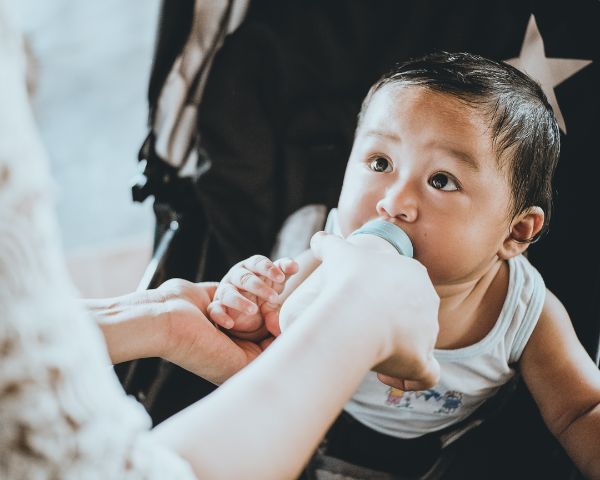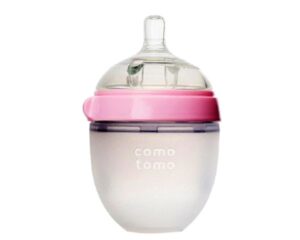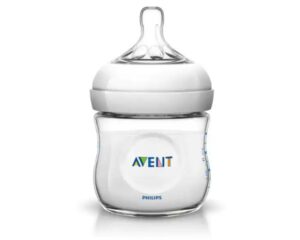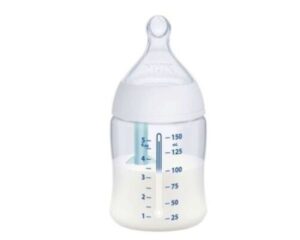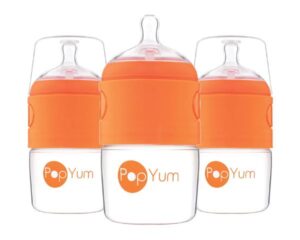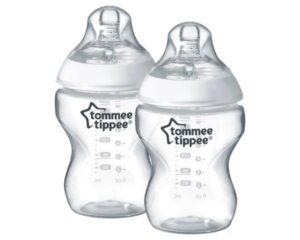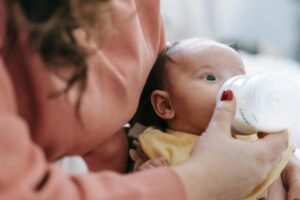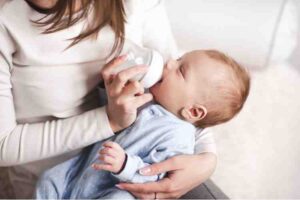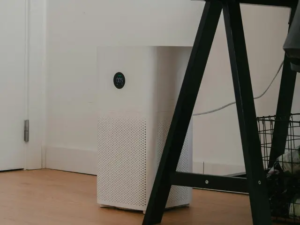Feeding is a number one priority so you must choose the right method for you and your baby. There are so many options out there it can be difficult to know where to start and what to choose. Different methods and different bottles can work for different parents and breastfed babies so it’s important to be patient and experiment to see which methods work best for you.
As much as you might want to breastfeed 100% of the time, it isn’t always a sustainable option. Sometimes situations mean a bottle is easier or when you return to work and you’re not around, so it’s important they are able to do so without any trouble. We’ll aim to give you all the necessary information to help you choose the best bottles for breastfed babies to minimize nipple confusion.
If you are considering flying with your baby, check out this article on traveling with breast milk. You may also be interested in reading up on airline bassinets and everything you need to know abou it.

What is nipple confusion?
Nipple confusion happens when a breastfed baby struggles to latch to the nipple. This can happen when the baby switches between breastfeeding and being fed from a bottle. It’s confusing for the baby because they drink the milk differently from a breast versus a bottle. Most bottles make it easier for babies to drink so they don’t need to suck as much as they need to when getting milk from the breast. Nipple confusion happens when the baby is bottle-fed and then struggles to get back into the technique of breastfeeding.
Strategies to prevent nipple confusion
Nipple confusion can be a stressful thing for the mother and the baby but there are some useful strategies you can put in place to minimize this happening when the baby is switching between breastfeeding and bottle feeding.
Establish breastfeeding first
Build confidence with breastfeeding before moving to the bottle. Once your infant is used to breastfeeding, they’ll find it easier to revert to this after bottle feeding. Make it a part of your daily routine and continue to do this until your baby successfully and confidently breastfeeds every time.
Most mothers would suggest waiting at least 4 weeks before trying to move over to feeding from a bottle. A study found that bottle-feeding breastfed babies before 5 weeks could cause more nipple confusion. [1] Ideally, wait as long as you can until your baby is confident and established in breastfeeding before feeding with a bottle.
Increase breast milk supply
Sometimes when your baby is using bottles it can impact your breastmilk supply. If they continually get bottle or formula feeds, then you may naturally start to produce less breast milk which may result in difficulty breastfeeding as you can’t produce enough milk needed for a feed. One way to increase your milk supply is to express your milk as often as possible.
Even if you’re away from the baby, try to pump to keep your supplies continually topped up. It’s recommended to pump at least 8 times a day, but this may vary so check with your doctor. Try your best to prioritize breastfeeding time over bottle feeding to ensure you keep your supply going.
Prevent over reliance on bottles
Some babies find feeding from a bottle easier as they don’t need to suck as much when drinking from a bottle. This can result in them preferring to drink from a bottle and cause nipple confusion as they don’t want to latch to you. If this happens be patient and proceed with breastfeeding as much as you can. If you do need to bottle feed, let someone else do this for you.
If someone else bottle feeds then the baby won’t be confused as much when you come back to breastfeeding. They’ll associate the mother with breastfeeding and not see the bottle as an option.
One of the best ways to prevent nipple confusion is to choose a bottle that works in a similar way to feeding from the breast. These two styles of feeding are different and the baby will need to adapt between the two. If you can minimize the difference between breastfeeding and bottle feeding then you will minimize the chances of confusion. Find a bottle that requires the same sucking motion that is needed when breastfeeding.
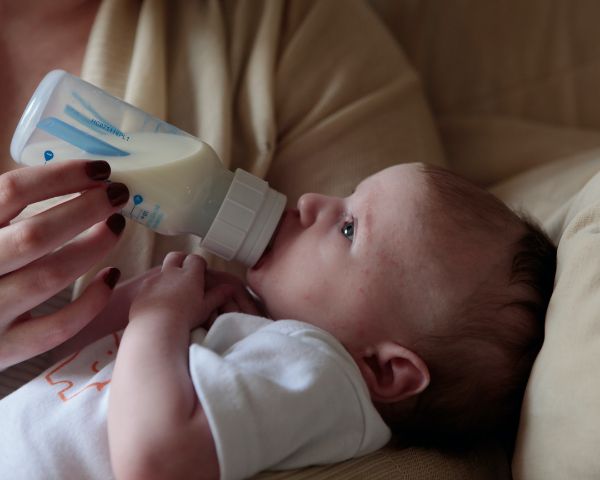
How to Choose the Tight Bottle for Breastfed Babies?
As mentioned above, choosing a bottle that feeds most similarly to breastfeeding will help your baby transition between the breast and bottle smoothly. There are many different types of bottles out there and it can be difficult to know which to choose. Here are some tips to help you choose the right bottle for breastfed babies.
Bottle Nipple
The nipple is one of the most important design aspects to consider when switching from breastfeeding to a bottle. Here are some factors to consider when choosing a bottle teat.
Slow flow
Choose a nipple that is most similar to breastfeeding. A slow-flow nipple will be the best option as the flow of milk from the bottle will be naturally slower and mimic that of the mother’s breast.
Width
It may help to choose a bottle with a narrow neck and a gradual slope so the baby can latch onto the bottle in the same way they would with the nipple when breastfeeding. Although wide-neck bottles may visually resemble a breast, it may be more difficult for your baby to put their mouth around it. Choose a width fit that best fits the baby’s mouth which they can comfortably drink from.
Fit
Ensure the nipple will fit with the bottle as not all nipples are compatible with every bottle. This is important to ensure there is no leakage.
Material
Silicone nipples will likely be the best option for breastfed babies as they are flexible and will be comfortable to drink from. These are a durable option and will last you the longest since you will likely go through a few bottle nipples.
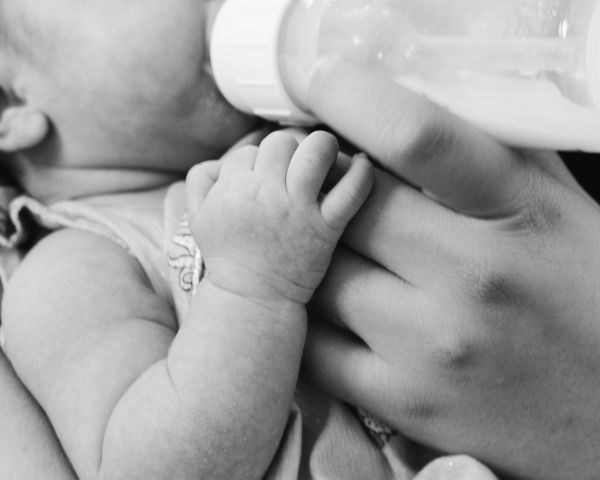
What to Look for When Choosing a Baby Bottle?
As well as the bottle nipple, there are other features of the baby bottle to take into account.
Connects to breast pumps
Choosing a bottle that directly connects to your breast pumps can make switching easier and quicker. If you want to make the process easier it’s a good idea to consider this option. Ensure you properly store and prepare the breastmilk to ensure it is safe for the baby to drink.
Anti-colic features
Bottles that are designed for anti-colic are made to reduce the amount of air that is swallowed during feeding. If your baby struggles with gas, crying, and overfeeding then they could be swelling too much air and need a specific anti-colic bottle to help slow down the flow of milk during the feed.
Ease of cleaning
Sterilization of the bottles is one of the most important aspects of bottle feeding. Choose a bottle that is easy to clean so make bottle feeding easier for you. Keep in mind that you may need to weigh up the options of having an easy-to-clean bottle versus an effective bottle. For example, anti-colic bottles are usually more difficult to clean. Self-sterilizing bottles might be the most time effective but they are also the more expensive. Wide-neck bottles might be the easiest to clean, but they might not be the easiest for the baby to drink from.
Bottle material
It is essential you choose a BPA-free bottle as some plastics can include chemicals that can be harmful to your baby. You can also opt for a glass bottle to ensure the bottle will be safe for your baby.

What Size Baby Bottle Do I Need?
There tend to be two sizes of baby bottles 4 to 5 ounces and 8 to 9 ounces. For newborn babies start with the smallest bottles which are 4 to 5 ounces. You can move up to 8 to 9 ounces when your baby gets to around 4 months old. It depends on your baby and how much they are feeding so consult your doctor for the most accurate advice.
When to Introduce a Bottle to Breastfed Baby?
The best time to introduce a bottle to a breastfed baby is once the baby is confident breastfeeding and it is part of their routine. Ideally, this should be no earlier than at least 4 to 5 weeks. However, if you need to have other people feed your baby then you might need to do this earlier. There will be nothing worse than trying to have someone else feed the baby when you are not there and they can’t take any of it. It all depends on your baby and its routine. Consult your doctor for the best advice as this depends on your baby and how they are feeding.
Switching from Breastmilk to Formula? Here are a Few Tips for You
Making the switch from breastmilk to formula can be tricky if your baby is used to breastmilk and breastfeeding. It may take them a little while to get used to the change and the new milk, but have patience and be persistent as your baby will make the switch eventually. Here are some tips to help you with a smooth transition between breastmilk and formula.
Skin-to-skin contact
Hold your baby while you feed them to emulate the same touch and feel as breastfeeding.
Get help from friends and family
It can be stressful trying to feed by yourself or just with your partner. Ask family and friends to bottle feed the baby when you can. This will help the baby be more confident with the bottle and take it from anyone and not just you.
Find the right bottle
Formula feeding will be easier when you have the right bottle. Choose a nipple that most mimics breastfeeding so it’s easier for the baby to adapt to the change. Make sure the nipple is the right fit for the baby’s mouth as it can be difficult for them to take if it is too big or wide.

Bottlefeed breast milk first
Before feeding formula from the bottle, feed breastmilk in a bottle first. This allows the baby to understand it is the same milk they were having before. Once they can drink from the bottle, then switching to formula will be easier.
Transition slowly
Don’t quit breastfeeding cold turkey if you can help it. Maintain breastfeeding while bottle-feeding to help ease the transition from one to the other. Slowly swap breastfeeds to bottle feeds until your breastfeeding is completely reduced.

11 Best Bottles for Breastfed Babies
Comotomo Baby Bottle
Designed to mimic the mother’s nipple, the Comotomo Bottles for breastfed babies help babies transition from breastfeeding to bottle feeding. The bottles are made of medical grade silicone which is safe for babies and soft like breastfeeding. The bottle nipple has a wide mound and a soft silicone nipple for easy transition and suction.
Pros: Silicone is soft and mimics breastfeeding. These bottles have anti-colic vents to prevent air from being swallowed. Easy to clean and easy for baby’s hands to hold.
Cons: The soft silicone of the bottle may cause it to fall over and leak until other sturdy bottles.
Philips Avent Natural Baby Bottle
Made with an ultrasoft teat, this bottle closely resembles the breast. It uses a flexible spiral design and petals to allow for a comfortable, natural latch-on.
Pros: The wide nipple-like shape and spiral design mimic the feel of a breast. BPA-free material. Easy to clean and sterilize.
Cons: Measurement numbers may rub off after repeated use which can make it difficult to measure if using a formula.
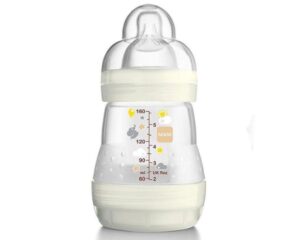

MAM Easy Start Anti-Colic Bottle
Ideal for switching from breastfeeding to bottle-feeding expressed milk, this bottle has a unique vented base that slows the flow of the liquid to mimic breastfeeding.
Pros: Dust cap to prevent spillage and acts as a measuring tool. Silicone slow flow nipples allow easy latching for a breastfed baby. The vented base for anti-colic. Self-sterilizes in 3 minutes.
Cons: Sterilization has been known to overheat the microwave. If not assembled correctly it will leak.
NUK Smooth Flow Anti-Colic Baby Bottle
The NUK Smooth flow baby bottle has a slow flow nipple to smooth the flow of milk to prevent the baby from ingesting too much air. The bottle adapts to the baby and flows depending on its suction strength.
Pros: Unique nipple design and air vent that allows baby to control the flow rate for colic-free feeding. The SafeTemp temperature indicator lets you know when milk is hot enough or too hot. BPA-free material.
Cons: The shape of the bottle may be difficult for the baby to grip at first.

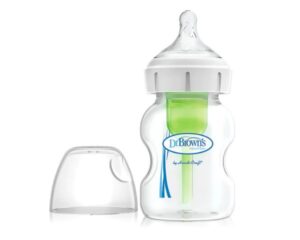
Dr Brown’s Breastfeeding Baby Bottles
Dr Brown has a wide variety of baby bottles to help your baby transition from breastfeeding to bottle feeding. There are anti-colic wide and narrow baby bottles, in different sizes in BPA material or glass. Brown’s glass baby bottles are great for storing pumped breast milk.
Pros: Anti-colic vent system and breast-like slow flow nipples for easy latching and slow flow liquid.
Cons: Cleaning the vent system can be time-consuming as there are a few parts to assemble.

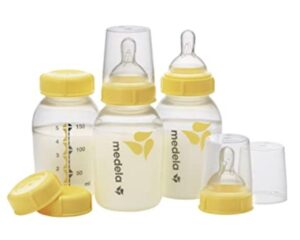
Medela Breast Milk Storage Bottles
Designed for the safe and long-term storage of your breast milk. These bottles are ideal if you need to pump in advance and bottle feed later on. The bottles are BPA free and safe for microwave and dishwasher use.
Pros: Compatible with Medela breast pumps and other Medela products. Screw-on bottles mean leak-free feeding.
Cons: Can be difficult to clean because of all the different parts.
PopYum Anti-colic Baby Bottles
The PopYum baby bottles are ideal for formula-fed babies. The design allows for quick mixing of the formula all in one bottle. The bottles feature an anti-colic vent and natural nipple-like teat.
Pros: Design and pop features make it easier to mix formula when needed with one hand. Wide bottle easy for cleaning.
Cons: Prone to leaking, and milk flow not controlled as well as other bottles.

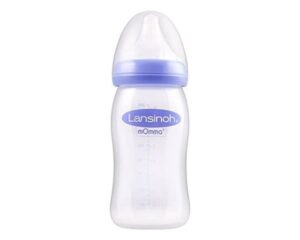
Lansinoh Baby Bottles for Breastfeeding Babies
Nipple design is clinically proven to reduce confusion between bottle and nipple. Flow and suction are similar to breastfeeding. BPA-free bottle and silicone bottle nipple.
Pros: Few parts for easy cleaning. Nipple design makes for easy latching and feeding. Smaller and easier for newborns to use.
Cons: Liquid can flow too fast for some babies.
Tommee Tippee Closer To Nature Baby Bottle
Designed to help babies transition from breast to bottle, the closer to nature baby bottle by Tomme Tippee is designed like a breast. It’s shaped like a breast with a soft nipple. The silicone teat is flexible and soft and makes latching on easy. This bottle features a vent to reduce excessive airflow.
Pros: BPA-free and easy to clean. Flexible and soft silicone teat makes it easier for babies to latch.
Cons: Shape may be difficult and uncomfortable to hold.

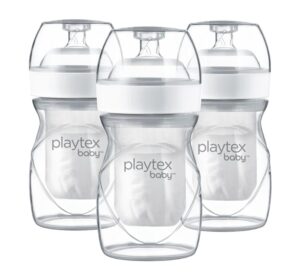
Playtex Baby Nurser Bottle
The angled design of this bottle promotes semi-upright feeding to help prevent ear infections when feeding. The wide shape helps babies transition from breastfeeding as it feels most like a breast. The soft silicone nipple makes it easy to latch and drink from.
Pros: Vents to prevent colic. Soft silicone teat. Angled ecogonmic design.
Cons: Some people find this bottle leaks.

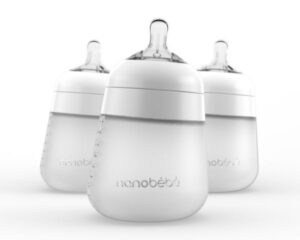
Nanobebe Flexy Silicone Baby Bottles
These silicone bottles mimic the breast to feel soft to the baby’s touch. They have a vent to prevent the ingestion of too much air.
Pros: Soft silicones make the easy transition from breastfed to bottle-fed. Babies love the touch and hold of these bottles. Easy to clean.
Cons: Some parents report the liquid flow is too fast for their little one.

Choose Your Baby Bottle with Confidence
Transitioning from breastfeeding to bottle feeding can be difficult and may cause nipple confusion. To prevent this choose a bottle that is most like breastfeeding and gradually transition from one method to the other. Only start bottle feeding once your baby is confident breastfeeding and try and have other people bottle feed to ensure your baby will continue to breastfeed with you. Choose one of the best bottles to help your baby feed easily.
References:
[1] Chanprapaph et al; The Impact of Teat and Bottle Design on Nipple
Confusion: A Double-Blind Randomized Controlled
Trial. Research Gate (2022)

